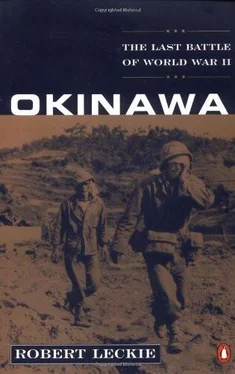Fleet Admiral Nimitz was still in overall command in Hawaii as he had been when the Japanese were stopped at Midway, when the long charge began at Guadalcanal. Admiral Raymond Spruance commanded the Fifth Fleet, and there was the saltiest salt still giving orders to the expeditionary force. Vice Admiral Richmond Kelly Turner had brought the Marines to Guadalcanal and now, nearly three years later, still roaming his flagship bridge in an old bathrobe, still a profane perfectionist with beetling brow and abrasive tongue, a matchless planner who would also not scruple to tell the coxswain how to beach his boat, Kelly Turner was bringing the Tenth Army to Okinawa. Many of the officers and men aboard Turner’s ships—especially the Marines—were not ecstatic to have the Old Salt in charge.
The Leathernecks could not forget his monstrous blunder at Guadalcanal, when he was the Amphibious Force commander at this first invasion in the long-awaited American counter-offensive. In the night of August 8-9, 1942, the Battle of Savo Island—better known to the sailors and Leathernecks involved as “the Battle of the Four Sitting Ducks”—Turner had lost four cruisers: Astoria, Quincy, Vincennes, and the Australian Canberra, while a fifth, Chicago, had its bow blown off. He lost them because he violated a commander’s basic principle: never act on the premise of what you think the enemy will do but what he has the capacity to do. Thus, he was unprepared for battle when a Japanese task force led by Rear Admiral Gunichi Mikawa, the hero of Pearl Harbor, came tearing down the Slot the day after the Americans landed to surprise Turner in a disaster that might have been a catastrophe. Guadalcanal might have been reconquered by the enemy but for the tenacity of the Marines whom Turner quickly abandoned—and wisely so, his fire support force having been almost annihilated—sailing away with empty transports and some supply ships not even half unloaded, others still deep in the water. And the U.S. Navy did not return to Guadalcanal in force until three months later. But for Turner’s friendship with Nimitz, he might have lost his head just as Admiral Husband Kimmel did at Pearl Harbor. But he did come back again and again—risking his ships in the submarine-infested waters of the Coral Sea, to bring reinforcements and badly needed supplies to Major General Alexander Vandegrift.
This writer well remembers the Four Sitting Ducks, for our battalion was lost in the jungle that night, and the monster explosions that shook the trees and flames that seemingly set the clouds on fire were not suggestive of good times to come. When we returned to the beach the next day and saw not a single ship on a bay that had been full of masts twenty-four hours earlier, we knew that we were all alone. Worse, our ship, the George F. Elliott —an African slaver if ever there was one—had been sunk on D day by a Zero that crashed her amidships, sending all our supplies—beans, bullets, and barbed wire—down to the bottom, along with our extra clothing and mosquito nets, so that many of us quickly came down with malaria, and the first time I shot a Jap, I had Jap clothing on. We also lived on wormy Japanese rice for the next few months. Worse for me, the portable typewriter that my mother had given me on my sixteenth birthday also sank into Davy Jones’s locker, thus wrecking my naive plan to fight by day and write by night.
So those Americans sailing toward Okinawa who had been on “the Canal” were not enchanted to have Kelly Turner at the helm again. It was well known that he was a constant thorn in Vandegrift’s flesh, trying to take personal command of the reinforcements he brought to the island, planning to deploy them in tactical traps when actually he had no authority on land arid knew exactly nothing about ground warfare. One infuriated officer wrote: “Turner was a martinet; very, very gifted, but he was stubborn, opinionated, conceited … thought that he could do anything better than anybody in the world… By and large naval officers, they were wary of trying to run land operations, but Turner, no; because Turner knew everything!”
Soldiers who served at New Georgia in the Solomons also were given a sampling of Admiral Turner’s hectoring style when he was playing general—especially Major General Oswald Griswold, commander of the Army Fourteenth Corps. Turner repeatedly usurped Griswold’s authority, divided his staff, and—his critics maintained—prolonged what turned out to be a miserable campaign. Whether or not General Simon Bolivar Buckner was aware of Turner’s tendency to interfere is not known, and it may be that the Tenth Army commander as a newcomer to the Central Pacific was unfamiliar with the amphibious chief’s abrasive personality.
Buckner was the son of the Confederate general of the same name, so often described by many military historians as “famous.” Actually, Buckner’s father was rather more infamous throughout the Southland, for it was he who had accepted the humiliating terms of unconditional surrender of Fort Donelson offered to him by his fellow West Point cadet U. S. Grant. It was to Grant that this adjective famous really applied, for he did become famous—not only because his capture of Donelson was received in the North with delirium (these were the early dark days of defeat and retreat for the Union) but also because his initials U.S. fitted his feat, and he became known thereafter as “Unconditional Surrender” Grant. Buckner junior—for some inexplicable reason called “the Old Man of the Mountain”—was definitely unlikely to submit to the sort of bluff Grant ran on his father. A big man, ruddy-faced and white-haired, avid for the conditioning of troops, he had served four years in Alaska and the Aleutians, where he had improved the defenses of the North Pacific. He had hoped to lead the invasion of Japan from this region, but the thrust from the Aleutians was never made. Instead it was coming from the Central Pacific, and Buckner had been called to Hawaii to lead it. His command was the Tenth Army, a new number for seven old divisions. These were the Seventh, Twenty-seventh, Seventy-seventh, and Ninety-sixth Infantry Divisions of the U.S. Army Twenty-fourth Corps commanded by Major General John Hodge, and the First, Second, and Sixth Marine Divisions of the Third Amphibious Corps under the silver-haired veteran of Guadalcanal, Major General Roy Geiger.
All of these troops, and especially the replacements who fleshed out formations left understrength by battle losses, disease, or accident, hated the Pacific with a fierce, personal venom. Upon arriving in the islands they stood breathless at the rail of their transports, drinking in the beauty of a tropical paradise seen from the sea, especially at sunrise or sunset. But then, when they went ashore—even on a peaceful island—they saw the backside of beauty, a face as hideous as Medusa’s. The first to be so disillusioned by the ambivalent South Seas were the men of the First Marine Division when they came on deck the morning of August 7, 1942, who stood at the rail of their ships studying Guadalcanal. My buddies and I—waiting to follow our machine guns down the cargo nets to the wooden Higgins boats waiting and wallowing in the swells—were enchanted until after we landed. Years later, I remembered that scene:
She was beautiful seen from the sea, this slender long island. Her towering central mountains ran down her spine in a graceful east-west keel. The sun seemed to kiss her timber-line, and lay shimmering on open patches of tan grass dappling the green of her forests. Gentle waves washed her beaches white, raising a glitter of sun and water and scoured sand beneath fringing groves of coconut trees leaning languorously seaward with nodding, star-shaped heads.
Читать дальше










